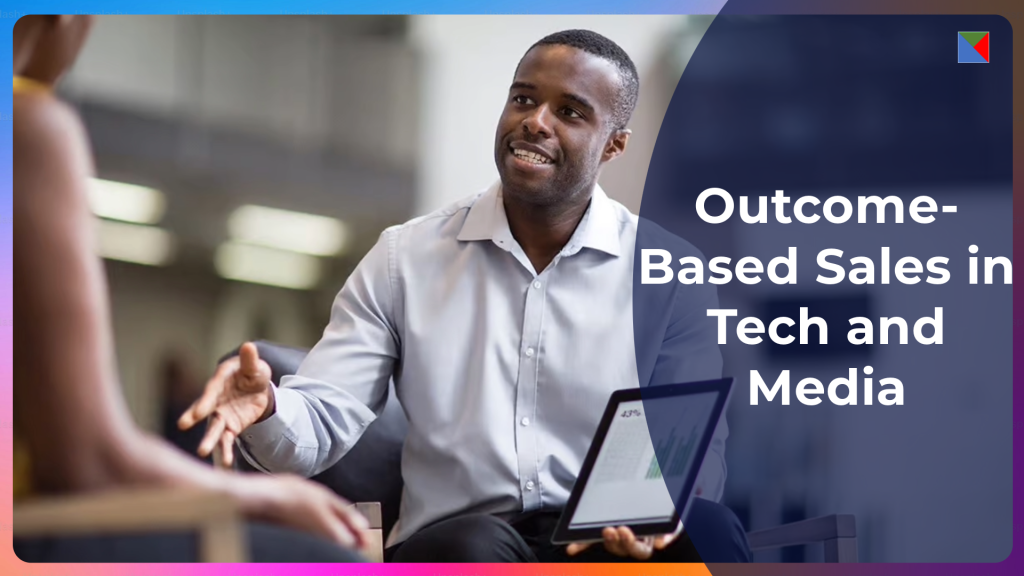
The Rise of Outcome-Based Sales in Tech and Media
A Tale of Two Media Tech Companies
Consider two enterprise software companies, each vying for dominance in the booming field of digital collaboration. “Synergy Solutions,” the established player, relied on a seasoned sales force armed with compelling feature lists and competitive pricing tiers. Their quarterly reports showed steady new sign-ups, powered by relentless outreach and rapid-fire pitches—closing deals of any size, in any sector.
Meanwhile, a younger, more agile competitor named “FlowState” operated with a markedly different philosophy. Their sales interactions seemed less about product specifications and more about pinpointing each client’s unique operational challenges—and mapping those directly to customized solutions. One notable case involved a mid-sized media firm struggling with bottlenecks in cross-departmental project management. Synergy Solutions promptly pitched its robust feature set and offered discount bundles to entice a quick deal. FlowState, by contrast, spent several weeks mapping the client’s existing workflows, identifying the root causes of delays, and collaboratively designing a plan to fix them. FlowState’s final proposal illustrated precisely how the platform would compress production timelines, reduce errors, and measure success at key milestones.
The result? FlowState secured a long-term, high-value contract, while Synergy Solutions’ broad-stroke approach, though initially generating more inquiries, failed to address the client’s deeper needs.
Why focusing on outcomes prevails
This fictional story raises a central puzzle for today’s B2B tech and media leaders: in markets awash with sophisticated solutions and unending sales pitches, why did a company that talked less about the “what” of its product and more about the “how” of tangible business impact clinch the more lucrative deal?
In an era of data-rich CRM systems, advanced lead-scoring algorithms, and AI-driven analytics, why do so many sales organizations still find themselves treading water—exhausting resources without unlocking meaningful or sustained revenue growth? Is there a vital, often overlooked ingredient that separates high-velocity sales activity from truly transformative outcomes?
Data, Insights and Industry Voices
Increasingly, success stories like FlowState’s showcase a profound shift from what was once known as “solution selling” to a deeper, more consultative approach: outcome-based selling. Traditional methods often revolve around features and benefits, hoping to match them with perceived pain points. But today’s B2B buyer—especially in the Media and Entertainment sector, where new revenue models and emerging streaming platforms demand creativity—expects measurable results and strategic alignment. Buyers want to see how technology investments directly serve overarching business objectives in real, trackable ways.
Recent findings from TSIA reveal that while 96% of technology companies have a dedicated customer success function, only 27.2% measure the actual business outcomes their solutions deliver. As our CEO points out:
“How can you truly focus on your customer’s success if you don’t understand how your offers contribute to the achievement of what matters most to the people who buy them?”
This disconnect underscores the gap between what companies sell and what customers genuinely need.
To bridge this gap, sales teams must adopt what we call “Deep Discoveries”—conversations that extend well beyond surface-level requirements to explore the client’s strategic vision. These discussions range from micro-level concerns—like a particular department’s workflow issues—to macro-level considerations, such as the organization’s cultural and financial objectives. Clients and providers should collaboratively develop value statements tied directly to business goals, evaluating progress against these statements as projects unfold.
Contrasting Viewpoints in Action:
- Case Study 1: The CRM Pitch
A traditional CRM vendor touts its extensive feature array—lead management, email integration, dynamic dashboards. While these updates sound impressive, they fail to address a struggling e-commerce company’s core dilemma: rising customer churn and stagnant repeat purchases. Even if the vendor secures a sale, the client’s deeper challenge remains unsolved—a mismatch that all too often leads to dissatisfaction down the road. - Case Study 2: The Cybersecurity Partnership
A modern cybersecurity provider targeting a financial institution first uncovers specific compliance pains and calculates the potential cost of a breach—including legal fees, PR fallout, and lost customer trust. The proposal then focuses on how a tailored framework not only aligns with critical regulations but also demonstrably reduces breach risks, coupling each recommendation with clear metrics. This customized, outcome-centric offering resonates strongly with the client’s strategic objectives and results in a lasting relationship.
Data-driven insights and AI-driven analytics now fortify this outcome-based approach. Rather than guessing where a solution might fit, companies can harness real-time analytics to spot high-impact deals and personalize offers for each client. Scratchpad urges sales teams to replace “I think” with “I know,” capitalizing on historical data, demographic insight, and usage patterns to tailor the conversation around specific outcomes. In the Media and Entertainment realm—where subscription revenue, retention rates, and fan engagement metrics often drive profitability—this data-savvy mindset can shorten sales cycles and elevate client confidence.
Yet perhaps more important than the data itself is building trust-based relationships that establish your organization as an invaluable partner. nGülam emphasizes the need for credibility, respectful communication, and an understanding that—no matter the industry—clients know their business best. By staying humble, explaining your process clearly, and offering sincere guidance, you stand out as a consultative ally rather than just another vendor.
The True Drivers of Sustainable Growth
The pivotal, and frequently overlooked, revelation is this: sustainable, transformative growth in tech and media B2B markets isn’t driven solely by selling more “stuff”—it’s catalyzed by systematically delivering real-world outcomes. In other words, your clients’ success isn’t supplementary motivation; it’s the beating heart of your own. Companies pioneering outcome-based sales treat themselves almost like co-architects of their clients’ future state, crafting proposals that tie technology design, implementation, and measurement back to tangible, agreed-upon goals.
At first glance, this seems counterintuitive: conventional wisdom suggests a robust product pipeline should suffice. Yet, the most valuable asset you can cultivate isn’t just innovative tech; it’s the proven ability to orchestrate that tech to elevate a client’s specific metrics—be it revenue growth, churn reduction, faster production, or deeper fan engagement. When you become a trusted strategist dedicated to realizing those gains, you shift from vendor to partner, securing opportunities for predictable revenue growth and forging a reputation that endures.
Why it Matters to B2B Decision-Makers
For C-suite executives at B2B companies in the Tech and Media sphere, an outcome-based framework offers a powerful paradigm for orchestrating next-level revenue and market competitiveness. The old playbook—haggling over add-ons and highlighting new “bells and whistles”—is no longer enough. Clients demand holistic, value-driven engagement, grounded in real data and mapped to real results. Here’s how leaders can transform their organizations:
- Embrace an Outcome-Centric Culture
This shift demands concerted leadership from the top. Instead of measuring success purely by the number of deals closed, link performance metrics across teams—sales, marketing, product, and customer success—to the results delivered for clients. Let potential buyers see that your core mission is tied to their tangible outcomes, not just booking a quick sale. - Cultivate Deep Discovery Skills
Equip your teams with the consultative selling techniques and frameworks that elevate them from mere product experts to strategic advisors. This involves active listening, adept questioning, and a willingness to customize solutions around the client’s objectives, no matter how niche or industry-specific they may be (like optimizing content monetization strategies for global media operators or leveraging real-time analytics for interactive entertainment platforms). - Leverage Real-Time Data Intelligence
Build—or invest in—robust analytics infrastructures that collect and analyze metrics relevant to client outcomes, from pipeline velocity to subscription renewal rates. This allows your organization to anticipate challenges, evaluate success metrics early, and refine approaches to shorten sales cycles and enhance client relationships. - Drive Alignment Between Sales and Success Teams
If your sales team is promising improved subscriber retention, your customer success function must actively track and deliver that boost. Closing deals with promises of tangible results only works if the rest of the organization follows through. Encouraging cross-functional collaboration—potentially under a centralized Chief Revenue Officer—ensures continuity from negotiation to implementation and beyond. - Adapt to Unique Industry Demands
For media and entertainment stakeholders, outcome-based selling often hinges on understanding audience dynamics, brand loyalty, and emerging revenue streams—such as curated subscriptions, licensing deals, or multinational co-productions. Aligning your technology or solution with these specialized goals not only helps close deals but also cements your standing as a long-term partner who genuinely moves the needle.
This is precisely where nGülam’s revenue growth management consulting services seamlessly integrate. By partnering with B2B companies in Tech and Media, nGülam can help diagnose existing sales processes, champion the shift to outcome-based engagement, and unify team structures around shared success metrics. Their fractional leadership model and data-driven frameworks reduce guesswork, building a flexible yet consistent approach to delivering verifiable client results and orchestrating long-term, predictable growth.
A Reflection for Lasting Market Leadership
As you reflect on your current revenue strategies, ask yourself whether your sales efforts are focused on broadcasting technical capabilities—or whether you’re meticulously designing genuine pathways to each client’s strategic objectives. In an environment where Media and Entertainment companies combat streaming churn, seek new monetization models, and strive for deeper audience engagement, that subtle shift in orientation might just be the hidden architecture separating fleeting success from enduring market leadership.
Are you merely selling features, or are you engineering outcomes that define your clients’ future achievements? Sometimes, the biggest wins come not from what you’ve built, but how you’ve helped others build their success. Outcome-based sales is more than just a tactic—it’s a promise that you stand shoulder to shoulder with your clients, co-creating a vision that transcends transactional selling and becomes a catalyst for genuine transformation.






